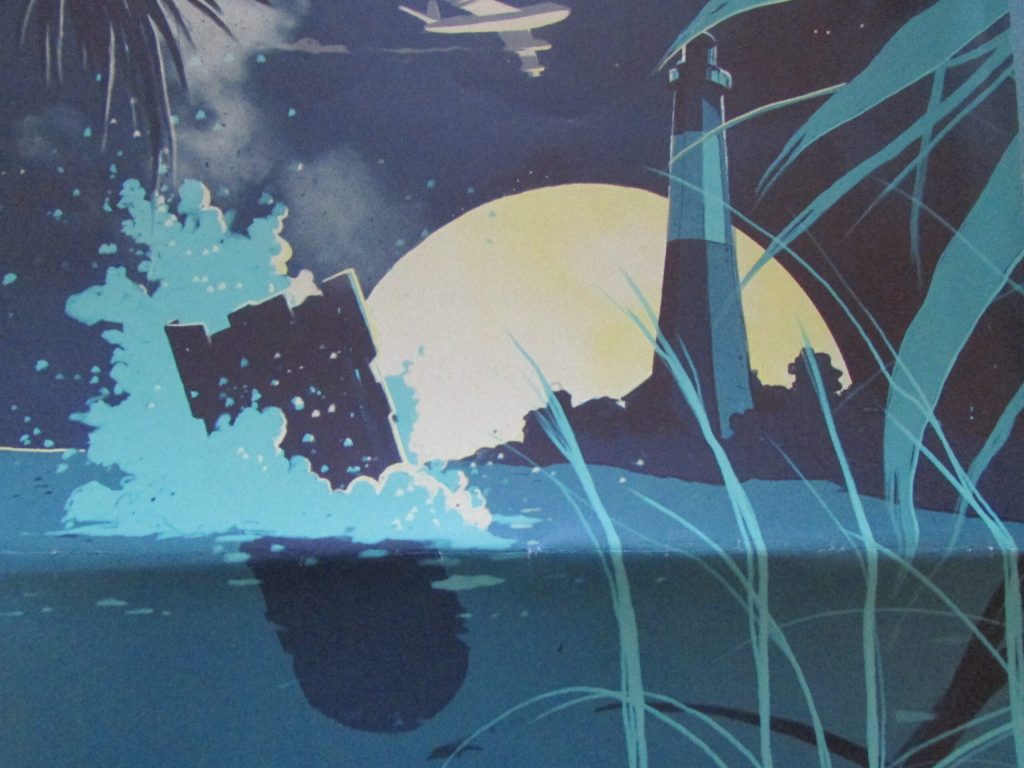The Bomb That Loved an Island-Tybee Island-Part 2
Published 12:24 pm Sunday, July 21, 2024
|
Getting your Trinity Audio player ready...
|
Everyone and, it seems that everything, wants to live on an island and it seems that nuclear bombs are no exception. You may remember an incident that happened during the Cold War era, on February 5, 1958, right here in Georgia. The area involved a comfortable, peaceful, barrier island, located off of Georgia’s Atlantic Coast, and was the home of about 4000 folks back in the 1950s, called Tybee Island. So, grab your beach chair and sunscreen and lets go set on the shore and reminisce about this island’s history.
During its colorful history, around the 1400 and 1500s, pirates visited Tybee Island and it was their haven for decades. Next, General James Oglethorpe, the founder of Savannah, built a small fort on Tybee Island in 1733. It was here that one of the bloodiest battles of the Revolutionary War, took place as the American and the French troops tried to hold off the British troops, who were trying to capture Savannah. Tybee Island also played a role in the War Between the States.
Only recently, a War Between the States mine was discovered at the entrance of the Savannah River. In this day and time, most residents believe that there is also a nuclear bomb just off the shores of their island. They believe that it is unstable and could go off at any time since it is one of Americas earliest nuclear weapons.
The bomber involved was a B-47, which was on a simulated combat mission from Homestead Air Force Base in Florida. The pilot was Major Harold Richardson. The bomb in question, is a 7,600-pound, Mark 15, hydrogen bomb, that is 12 feet long and has the serial number 447782. It is made of 400 pounds of conventional, high explosives and highly enriched uranium and is 100 times more powerful than the one dropped on Hiroshima in 1945. The Air Force insists that to detonate the nuclear capsule, a plutonium trigger is necessary and that it was removed prior to the flight. The other key player in this event was an F-86 fighter jet.
Everything started in motion at about 2 am. on February 5, 1958, when the B-47 bomber collided with the F-86 jet. The fighter plane crashed, after the pilot parachuted out. However, the damaged bomber was still in the air. Not wanting to crash with the bomb on board, the plane headed out to sea where the pilot requested permission to jettison the bomb. Permission was granted and the bomb was dropped when the plane was 7200 feet in the air, traveling at 200 miles per hour.
The crew watched but did not see an explosion when the bomb hit the water off of Savannah in Wassaw Sound. However, they managed to land the bomber safely at Hunter Air Force base. The very next day, the Air Force 2700 Explosive Ordinance Disposal Squadron and 100 Naval personnel began looking for the runaway bomb. They were equipped with the latest in search equipment at this time: a hand held sonar, and cable sweeps. Everything they needed to successfully find the bomb. An intensive search then ensued.
The Air Force was anxious to recover its missing ordinance. However, during this time, the Air Force stated that the bomb did not have its nuclear cap and therefore it was not armed. After thirty square miles and two months of intense searching, the Air Force called off the search on April 6, 1958. Based on reports of the water in the area, they believed the bomb to be under about 15 feet of silt from the Savannah River, in Wassaw Sound. With this, Tybee Island slipped back into its quiet ways. The story of the missing bomb was only shared over campfires and on the front porch.
Then, in 2001, interest in the bomb once again came to the forefront. The Air Force conducted an investigation to determine whether the bomb posed a direct threat to the residents of Tybee Island and the surrounding Savannah area. They stated that the bomb did not pose a threat because the nuclear capsule needed to initiate the nuclear blast was not installed. However, someone stumbled upon an official document that stated the bomb was a “complete weapon”, confirming what the bomber pilot had stated many years ago, that it was armed.
The Air Force stated that the spread of heavy metals, which may be leaching from the bomb, was a low risk. However, there would be no attempt to move it because there could be an accidental detonation of all that TNT. This could seriously damage the regional aquifer and the local drinking water. The Air Force concluded that it is best to leave the bomb where ever it is, undisturbed on the sea floor, smothered in mud and silt, after years of hurricanes and tropical storms that had churned up the waters.
In 2004, Air Force Colonel Derek Duke, claimed to have found the possible location of the bomb. He believed that it was in 12 feet of water, less than one mile from shore. He said that he and his partner found this place when they were trolling this area, in a boat with a Geiger counter in tow. Duke’s claims sparked interest in recovering the bomb once again.
The Air Force again sent a team to search. They released their findings in June of 2005, stating that the high radiation levels detected by Duke came from natural materials located in the swamp. Therefore, the location of the bomb is still unknown.
However, all of this changed on February 13, 2015. Canadian tourists, Jason Sutter and Christina Murray, were diving in the waters of Wassaw Sound. As they swam, admiring the sea life, Jason stumbled upon an unusual shape, partially covered with sand and silt.
Jason further investigated the large cylindrical shape. When he saw the etchings in the metal stating Mark 15, he knew what it was. Grabbing Christina by the arm, he gave her the sign that they had to leave the area, immediately! Once on shore, they called 911. Wasting no time, the Navy had 20 ships and 1500 men at the GPS coordinates that they were given by the couple. They rapidly found the once elusive bomb. An unmanned submarine carefully investigated the cylinder to see what shape it was in. It was determined that the bomb was sufficiently in good enough condition to be removed. In 48 hours, the bomb was at Mayport Naval Station in Florida. Next, it went through a full set of tests on the warhead to evaluate its condition, especially if it was a health hazard. There have been no conclusions to date as to if it is a hazard.
For now, I guess we can join ranks with those folks in Roswell, New Mexico. They have Area 51 and we Georgians have our Tybee Island bomb, which was one of 14 missing from the United States arsenal. How do you lose something that is the size of a bomb?
With all that went on around Tybee Island, naturally it also has a ghost. This was discovered by two college girls that chose to go to Savannah and then over to Tybee Island. The first thing that they wanted to do was to go onto the beach. When they got out of their car and were standing on the sand, they noticed that the surf had gotten rough and white caps were starting to form. Dark clouds began to move in and it was getting colder. These were signs they chose to ignore.
As they were laying down their beach towels, they were startled when they saw something coming up on to the shore from out of the surf. As they watched, the figure came closer to them. It appeared to be a woman, coming out from the rough waters of the Atlantic Ocean. She was waist deep and then walked up into the shallow water. As they stared, the wind blew even more fiercely. Now, the woman began to walk towards them going from knee deep water into ankle deep surf. She wore a long dress, was covered in seaweed and was drenched.
The girls could see that the woman was too old to fight her way through the rough surf. Now they knew, they were seeing someone not of this earth.
As soon as her feet touched the dry sand, she stopped and began scanning the shoreline and seemed not to notice the trembling girls. As they watched speechless, she walked towards them.
“Have you seen my son?” she asked. They replied, “No ma’am”. The woman turned and walked away from them, vanishing before she reached the water.
This is when the girls noticed a little boy, about four years old, sitting on their right, building a sand castle.
Now, the girls decided to leave. Quickly, they gathered their belongings and walked swiftly back to the car. Their spring break now became a personal research project because of what they had witnessed on the beach that day.
The library on Tybee Island was open and they searched through the history books. This is when they discovered a newspaper article written in 2003, that contained the information they needed.
Launched in 1853, the “Mary Alice”, spent her early years as a merchant ship going between Baltimore and Charleston. During the late 1850s to 1860, she transported fortune hunters to Panama, Nicaragua and California. Then, the “Mary Alice”, became a blockade runner in 1861, serving in the War Between the States. She was captured during the siege at New Orleans and became a Union ship.
Then, in 1865, the old, side wheel steamship began its final journey from New York, loaded with passengers and freight. She was headed for New Orleans, on a route that would take her directly into a powerful hurricane, just a hundred miles off the coast of Savannah.
When disaster struck, many of the passengers jumped in the four lifeboats, and many others died in the forty-foot seas that night. The survivors were rescued by a sailing ship. However, most passengers were lost, having drowned in the rough seas.
Manifests were found that named those passengers who were pronounced dead. Included on the list, a mother and son, whose remains were never found. The girls felt that they had just met these two passengers on the beach that day.
Mary Diehl and her son. Robert, were from New Orleans. Sadly, they were on the ill-fated ship traveling south from New York. They clung to each other until they were sucked under the sea, where they laid together for more than a hundred years. Mother and son, along with the other dead at sea, were in a state of rest, that is, until several divers went out to explore the wreckage in search of the thousands of gold coins that were supposed to be on the ship. Because the divers didn’t have the right equipment and didn’t know how to do a thorough search, they came up empty. However, in the process, they disturbed the resting place of the mother and her son.
Finally in 2003, an expedition to search for the ship’s remains, specifically the lost coins, was launched by a company called, “Odyssey Marine Exploration Inc. out of Tampa, Florida. They were armed with sophisticated equipment and a high tec research vessel. They dove into 1700 feet of water and began to search the ocean floor.
Reading this, the girls now raced back out to the beach. However, when they reached the walkway, they stopped short of the sand. Again, the clouds were thickening with rain and a storm was moving in from the south. As they stared out onto the beach, they saw the woman, wet and disheveled, with ocean debris hanging from her hair. She was still searching the beach.
When the woman saw the girls, she walked towards them. “I know that you have seen him,” she shouted, her words drifting through the wind. One of the girls pointed down to a shallow gully near the ocean.
They watched as the woman walked towards it and there, Mary Diehl finally met up with her son, Robert. She bent down and squeezed him tightly in a hug. Then clasping his hand in hers, they walked together. The girls watched, breathless, as the pair headed back into the sea, until they were swallowed up by the fierceness of the waves.
The girls ran off the wooden walkway back to the car, screaming as they went. With shaking hands, the girl cranked up her car and the two went to drive off of Tybee Island.
Reaching a curve, the driver hit the brakes. On the right, lying on its side, was a giant, rusted anchor, and a stone bearing a weathered inscription. The girls got out and read it aloud: Anchor, circa 1840, salvaged from an old wooden sailing ship, the “Mary Alice”, discovered several miles off the north shore of Tybee Island.






